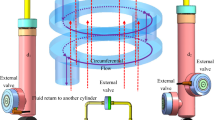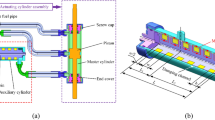Abstract
Based on the Bingham parallel-plate model, a simplified design method of shear-valve magnetorheological (MR) dampers is proposed considering the magnetic circuit optimization. Correspondingly, a new MR damper with a full-length effective damping path is proposed. The prototype dampers are also fabricated and studied numerically and experimentally. According to the test results, the Bingham parallel-plate model is further modified to obtain a damping force prediction model of the proposed MR dampers. This prediction model considers the magnetic saturation phenomenon. The study indicates that the proposed simplified design method is simple, effective and reliable. The maximum damping force of the proposed MR dampers with a full-length effective damping path is at least twice as large as those of conventional MR dampers. The dynamic range of damping force increases by at least 70%. The proposed damping force prediction model considers the magnetic saturation phenomenon and it can realize the actual characteristic of MR fluids. The model is able to predict the actual damping force of MR dampers precisely.
Similar content being viewed by others
References
Chooi WW (2005), “Experimental Characterisation of the Properties of Magnetorheological (MR) Fluids and MR Damper,” PhD thesis, University of Manchester, UK.
Chooi WW and Oyadiji SO (2008), “Design, Modeling and Testing of Magnetorheological (MR) Dampers Using Analytical Flow Solutions,” Computers and Structures, 86(3–5): 473–482.
Ding Y, Zhang L, Zhu HT and Li ZX (2013), “A New Magnetorheological Damper for Seismic Control,” Smart Materials and Structures, 22: 115003.
Dyke SJ and Spencer BF Jr (1996), “Seismic Response Control Using Multiple MR Dampers,” Proceedings of the 2nd International Workshop on Structural Control, Hong Kong, China, 163–173.
Dyke SJ, Spencer BF Jr, Sain MK and Carlson JD (1996a), “Modeling and Control of Magnetorheological Dampers for Seismic Response Reduction,” Smart Materials and Structures, 5(5): 565–575.
Dyke S J, Spencer B F Jr, Sain MK and Carlson JD (1996b), “Experimental Verification of Semi-active Structural Control Strategies Using Acceleration Feedback,” Proceedings of the 3rd International Conference on Motion and Vibration Control, Chiba, Japan, 291–296.
Dyke SJ, Spencer BF Jr, Sain MK and Carlson JD (1997), “An Experimental Study of MR Dampers for Seismic Protection,” Smart Materials and Structures, 7(5): 693–703.
Fujitani H, Sodeyama H, Hata K, Komatsu Y, Iwata N, Sunakoda K and Soda S (2002), “Dynamic Performance Evaliation of 200kN Magneto-pheological Damper,” Technical Note of National Institute for Land and Infrastructure Management, 41: 349–356.
Gavin HP, Hanson RD and Filisko FE (1996a), Electrorheological Dampers, Part 1: Analysis and Design,” Journal of Applied Mechanics, 63(9): 669–675.
Gavin HP, Hanson RD and Filisko FE (1996b), Electrorheological Dampers, Part 2: Testing and Modeling,” Journal of Applied Mechanics, 63(9): 676–682.
Gavin HP, Hoagg J and Dobossy M (2001), “Optima Design of MR Dampers, ” Proceedings of U.S.-Japan Workshop on Smart Structures for Improved Seismic Performance in Urban Regions, Seattle, USA, 225–236.
Guan XC, Ou JP (2001), “Magnetorheological Damper’s Damping Force Model and the Definition of Its Parameter,” Journal of Vibration and Shock, 20(1): 5–8. (in Chinese)
Jansen LM and Dyke SJ (2000), “Semiactive Control Strategies for MR Dampers: Comparative Study,” Journal of Engineering Mechanics, 126(8): 795–803.
Li ZX and Xu LH (2005), “Performance Tests and Hysteresis Model of MRF-04K Damper,” Journal of Structural Engineering, 131(8): 1303–1306.
Ou JP (2003), Structural Vibration Control-Active, Semi-active and Intelligent Control, Beijin: Science Press. (in Chinese)
Ou JP and Guan XC (1998a), “Magnetorheological Fluid Dampers and Their Properties,” Earthquake Engineering and Engineering Vibration, 18(3): 74–81. (in Chinese)
Ou JP and Guan XC (1998b), “Studies and Applications of Controllable Fluid Dampers,” World Information on Earthquake Engineering, 14(4): 30–40. (in Chinese)
Ou JP and Guan XC (1999a), “Experimental Study of Magnetorheological Damper Performance,” Earthquake Engineering and Engineering Vibration, 19(4): 76–81. (in Chinese)
Ou JP and Guan XC (1999b), “State-of-the-art of Smart Structural Systems in Civil Engineering,” Earthquake Engineering and Engineering Vibration, 19(2): 21–28. (in Chinese)
Spencer BF Jr, Carlson JD, Sain MK and Yang G (1997), “On the Current Status of Magnetorheological Dampers: Seismic Protection of Full-scale Structures,” Proceedings of the American Control Conference, Albuquerque, New Mexico, pp. 458–462.
Spencer BF Jr and Sain MK (1997), “Controlling Buildings: A New Frontier in Feedback,” Special Issue of the IEEE Control Systems Magazine on Emerging Technology, 17(6): 19–35.
Spencer BF Jr and Soong TT (1999), “New Applications and Development of Active, Semi-active and Hybrid Control Techniques for Seismic and Non-seismic Vibration in the USA,” Proceedings of International Post-SMiRT Conference Seminar on Seismic Isolation, Passive Energy Dissipation and Active Control of Vibration of Structures, Cheju, Korea, pp. 23–25.
Sunakoda K, Sodeyama H, Iwata N, Fujitani H and Soda S (2000), “Dynamic Characteristics of Magneto-Rheological Fluid Damper,” Proceedings of the SPIE’s 7th Annual International Symposium on Smart Structures and Materials, Hong Kong, China, pp.194–203.
Tse T and Chang CC (2004), “Shear-mode Rotary Magnetorheological Damper for Small-scale Structural Control Experiments,” Journal of Structural Engineering, 130(6): 904–911.
Xu LH (2003), “Theory and Experiment of Semi-Active Structural Control Based on MR Damper,” PhD dissertation, Tianjin University, China. (in Chinese)
Yang G, Jung HJ and Spencer BF Jr (2001), “Dynamic Model of Full-scale Magnetorheological Dampers for Civil Engineering Applications,” Proceedings of U.S.-Japan Workshop on Smart Structures for Improved Seismic Performance in Urban Regions, Seattle, USA, 213–224.
Yang G, Ramallo JC, Spencer BF Jr, Carlson JD and Sain MK (2000), “Large-scale MR Fluid Dampers: Dynamic Performance Considerations,” Proceedings of International Conference on Advances in Structure Dynamics, Hong Kong, China, 341–348.
Yang G, Spencer BF Jr, Carlson JD and Sain MK (2002), “Large-scale MR Fluid Dampers: Modeling and Dynamic Performance Considerations,” Engineering Structures, 24(3): 309–323.
Yi F, Dyke SJ, Caicedo JM and Carlson JD (1999), “Seismic Response Control Using Smart Dampers,” Proceedings of the American Control Conference, San Diego, California, 1022–1026.
Yi F, Dyke SJ, Caicedo M and Carlson JD (2001), “Experimental Verification of Multiinput Seismic Control Strategies for Smart Dampers,” Journal of Engineering Mechanics, 127(11): 1152–1164.
Yi F, Dyke SJ, Frech S and Carlson JD (1998), “Investigation of Magnetorheological Dampers for Earthquake Hazard Mitigation,” Proceedings of the 2 nd World Conference on Structural Control, Wiley, West Sussex, UK, 349–358.
Zhang L (2010), “New MR Dampers and Semi-active Control System of Long-span Spatial Structures,” PhD dissertation, Tianjin University, China. (in Chinese)
Author information
Authors and Affiliations
Corresponding author
Additional information
Supported by: The National Basic Research Program of China (973 Program) under Grant No. 2011CB013606, the Major Research Plan of the National Natural Science Foundation of China under Grant No. 91315301-06, the National Natural Science Foundation of China under Grant No. 51378343, the Natural Science Foundation of Tianjin, China under Grant No. 13JCZDJC35200, and the Specialized Research Fund for the Doctoral Program of Higher Education of China under Grant No. 20110032110042
Rights and permissions
About this article
Cite this article
Ding, Y., Zhang, L., Zhu, H. et al. Simplified design method for shear-valve magnetorheological dampers. Earthq. Eng. Eng. Vib. 13, 637–652 (2014). https://doi.org/10.1007/s11803-014-0269-2
Received:
Accepted:
Published:
Issue Date:
DOI: https://doi.org/10.1007/s11803-014-0269-2




